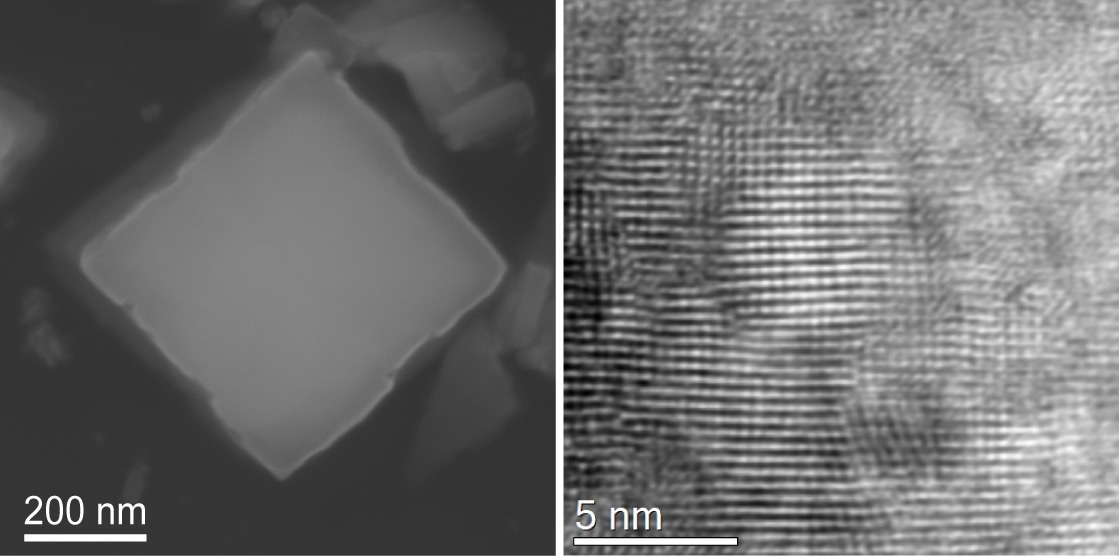Sunlight is an unlimited source of energy, and using sunlight to produce electricity is one of the bases of renewable energy. A research group from Hokkaido University, headed by Assistant Professor Melbert Jeem and Professor Seiichi Watanabe at the Faculty of Engineering, has synthesized tungstic acid-based materials that have been doped with copper to display all-solar utilization.
 (Left) A single copper-doped tungstic acid nanocrystal; (right) Atomic resolution image of the nanocrystal. Image Credit: Melbert Jeem.
(Left) A single copper-doped tungstic acid nanocrystal; (right) Atomic resolution image of the nanocrystal. Image Credit: Melbert Jeem.
Over 40% of the sunlight that falls on Earth comes under the visible, infrared, and ultraviolet spectra, but present solar technology makes use of primarily visible and ultraviolet rays. Technology to utilize the complete spectrum of solar radiation—known as all-solar utilization—is still in its beginning stage.
Their study outcomes were reported in the Advanced Materials journal.
Currently, the near- and mid-infrared spectra of solar radiation, ranging from 800 nm to 2500 nm, are not utilized for energy generation. Tungstic acid is a candidate for developing nanomaterials that can potentially utilize this spectrum, as it possesses a crystal structure with defects that absorb these wavelengths.
Melbert Jeem, Assistant Professor, Hokkaido University
The research group made use of a photo-fabrication method they had developed earlier, submerged photo-synthesis of crystallites, to synthesize tungstic acid nanocrystals that have been doped with altering concentrations of copper.
The structures and light-absorbing properties of such nanocrystals were examined; their photo-assisted water evaporation, photothermal, and photo-electrochemical characteristics were quantified.
The copper-doped tungsten oxide nanocrystals absorb light throughout the spectrum, ranging from ultraviolet through visible light to infrared; also, the amount of infrared light absorbed was greatest at 1% copper doping.
Nearly 1% and 5% copper-doped nanocrystals displayed the highest temperature elevation (photothermal characteristic); 1% copper-doped crystals also showed the greatest water evaporation efficacy, at roughly 1.0 kg per m2 per hour.
Structural analysis of the 1% copper-doped nanocrystals revealed that the copper ions might be deforming the crystal structure of tungsten oxide as a result of the noted characteristics when light has been absorbed.
Our discoveries mark a significant advance in advancement in the design of nanocrystallites capable of both synthesizing and harnessing all-solar energy. We have demonstrated that copper doping grants tungstic acid nanocrystal a variety of characteristics via all-solar utilization. This provides a framework for further research in the field as well as for the development of applications.
Seiichi Watanabe, Professor, Center for Advanced Research of Energy and Materials, Faculty of Engineering, Hokkaido University
This study was financially supported by the Japan Society for the Promotion of Science (JSPS) KAKENHI (20H00295, 21K04823). This work was partly achieved via a supercomputer system at the Information Initiative Center at Hokkaido University.
This work was performed at Hokkaido University, assisted by Advanced Research Infrastructure for Materials and Nanotechnology in Japan (ARIM) of the Ministry of Education, Culture, Sports, Science and Technology (MEXT).
Journal Reference
Jeem, M., et al. (2023) Defect Driven Opto-Critical Phases Tuned for All-Solar Utilization. Advanced Materials. doi.org/10.1002/adma.202305494.